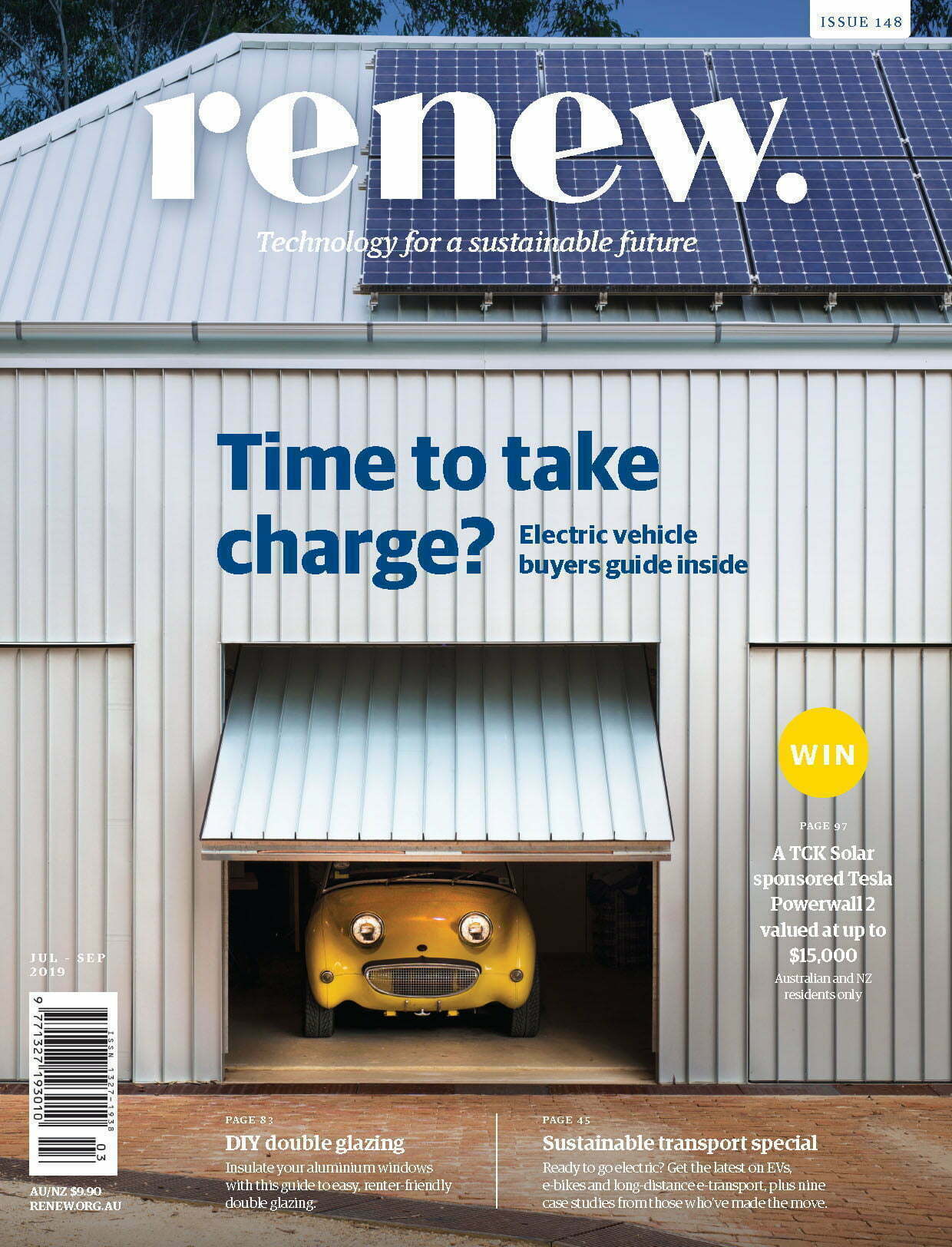Beyond the EV: reducing transport sector emissions
It’s not all about electric vehicles when it comes to reducing emissions from transport. Cameron Munro looks at where planning, technology and carrot/stick incentives converge.
We live in an era of hypermobility; the average distance travelled per day has increased sixfold since the 1950s. Moreover, many short trips that 50 years ago were made using public transport, or by walking or cycling, are now undertaken by car. Although it’s provided great economic and social benefits, this unprecedented mobility comes at a significant environmental cost.
The transport sector is now the second largest contributor to greenhouse gas emissions in Australia, and its emissions have grown more than any other sector since 2000 (Figure 1). Moreover, this excludes international aviation, which has experienced growth in passenger kilometres to and from Australia of around 5% per annum. This increase in emissions has been driven by a doubling in domestic aviation passenger kilometres, an 18% increase in passenger car kilometres and increasing emissions from transport associated with industrial uses (particularly mining); see Figure 2.
The ever-so-slightly good news is that passenger vehicle kilometres and emissions have both declined marginally on a per capita basis in recent years. However, reducing emissions to the extent required will entail a massive change in both our energy mix and, more broadly, how our cities are structured.
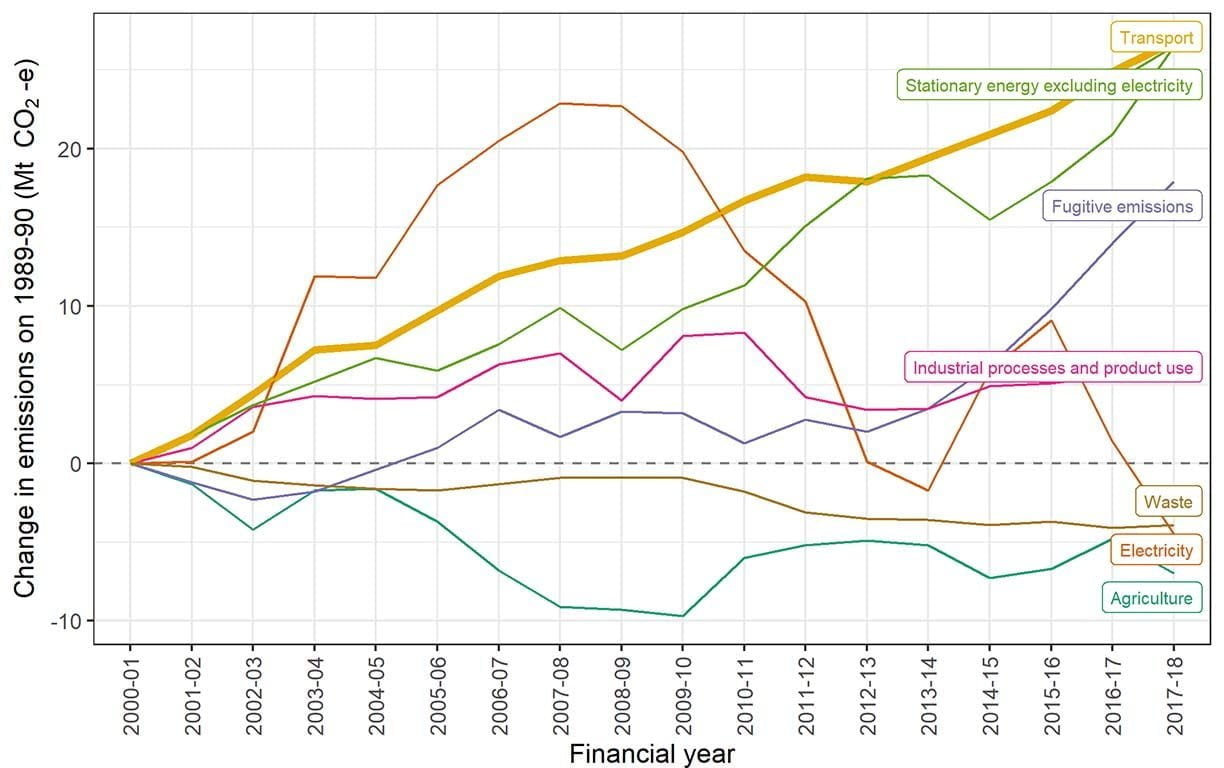
The car is the elephant in the room
Car travel is the dominant form of transport in Australia; nationally two-thirds of journeys to work are made by car (Census, 2016) and, even in cities with extensive public transport, most trip kilometres are by car. For example, in Sydney in 2017–18, 78% of trip kilometres were by car; similarly in Melbourne in 2014–16, 81% of trip kilometres were by car.1,2 And car use has been getting less efficient with declining car occupancy (see article on carpooling, p. 70).
This extensive use of the private car imposes significant costs on society as a result of road injuries and deaths, air quality deterioration, noise, obstacle to movement across major roads, physical inactivity leading to adverse health implications, and, of course, emissions. Private cars are estimated to account for 70% of kilometres travelled by all motor vehicles (cars, vans, trucks and motorcycles) and 57% of fuel consumed by motor vehicles.3
The only trips where the car is not the main form of transport are to the centres of our biggest cities (e.g. around 60% of trips to the Melbourne CBD are by public transport). The high level of non-car use when travelling to our major CBDs reflects both the design of our public transport systems (which tend to feed into the city centre) and the time and cost associated with driving to a city centre.
Fuel economy standards
Improvement in the fuel economy of the cars on the road has not kept up with the increase in vehicle kilometres. The average fuel economy of vehicles has improved by 4% since 2010, while vehicle kilometres have increased by 10%, resulting in a net increase in fuel consumption of 5.7%.3 There are currently no fuel economy or emissions standards for new vehicles in Australia, a situation that is almost unique in the western world. By comparison, the EU has a target for passenger cars of 95 g CO2/km for 2021 and
is proposing an average of 59 g/km by 2030. The USA has a target of 103 g CO2/km for 2025. The most recently available estimates suggest average new Australian light vehicle emissions are around 182 g CO2/km.4
The Australian purchasing trend is towards larger vehicles than in some other car markets, but there are opportunities for significant improvements in fuel economy without necessarily substantially changing vehicle type. For example, the National Transport Commission4 suggests that new vehicle emissions intensity would be 58% lower if all new buyers bought the most efficient vehicle in its class. Setting ambitious vehicle emissions targets along with financial incentives and penalties is likely to be the most significant action that can be taken to redress emissions in the near term. This can help accelerate the transition towards electrification.

Electrify everything
Combined with emissions regulation, the rapid decline in the cost of renewable energy and storage will very likely see the electrification of the non-air transport sector, including cars, vans, trucks, buses and diesel trains. While this will require an increase in electricity generation (assuming no improvement across other sectors of the economy), the increase required, at least for passenger cars, is neither technically nor economically unrealistic. In 2018, Australia generated around 261,400 GWh of electricity5 and passenger cars travelled a total of 180,000 million kilometres3. Assuming 180 Wh/km as an average electric car efficiency, the additional electricity required would be in the order of 32,400 GWh (neglecting transmission losses), or an increase of around 12%. Furthermore, electric cars can recharge outside other electricity demand peaks and, with smart grid technology, can also feed surplus electrical energy into the grid at peak times (see article on EVs and the grid, p. 76, for more).
The increasingly compelling economic motivation for electrification will drive the transition, although there is a strong role for government to reduce the risk of disruption in the energy and transport sectors. There’s also a risk that the lower costs brought by electrification will encourage even more travel (and driving in particular). Policymaking that minimises the risk of these perverse consequences is required.
Public and active transport
Increasing public transport and active transport (walking/cycling) can contribute to the abatement task, but that’s only likely where land-use patterns make them plausible and attractive options. The urban sprawl of most Australian cities makes it difficult.
Only a minority of employment is located in the centre of big cities—13% of employment in Melbourne is in the CBD for example—yet most of our rail networks are focused on radially serving the city centres. Very large and expensive public transport projects are proposed or under development such as the East Coast High Speed Rail, Sydney and Melbourne Metro and Brisbane Crossrail, but all are likely to provide only a small reduction in vehicle kilometres travelled. While they will improve the economic vitality of these centres, they come at a huge cost.
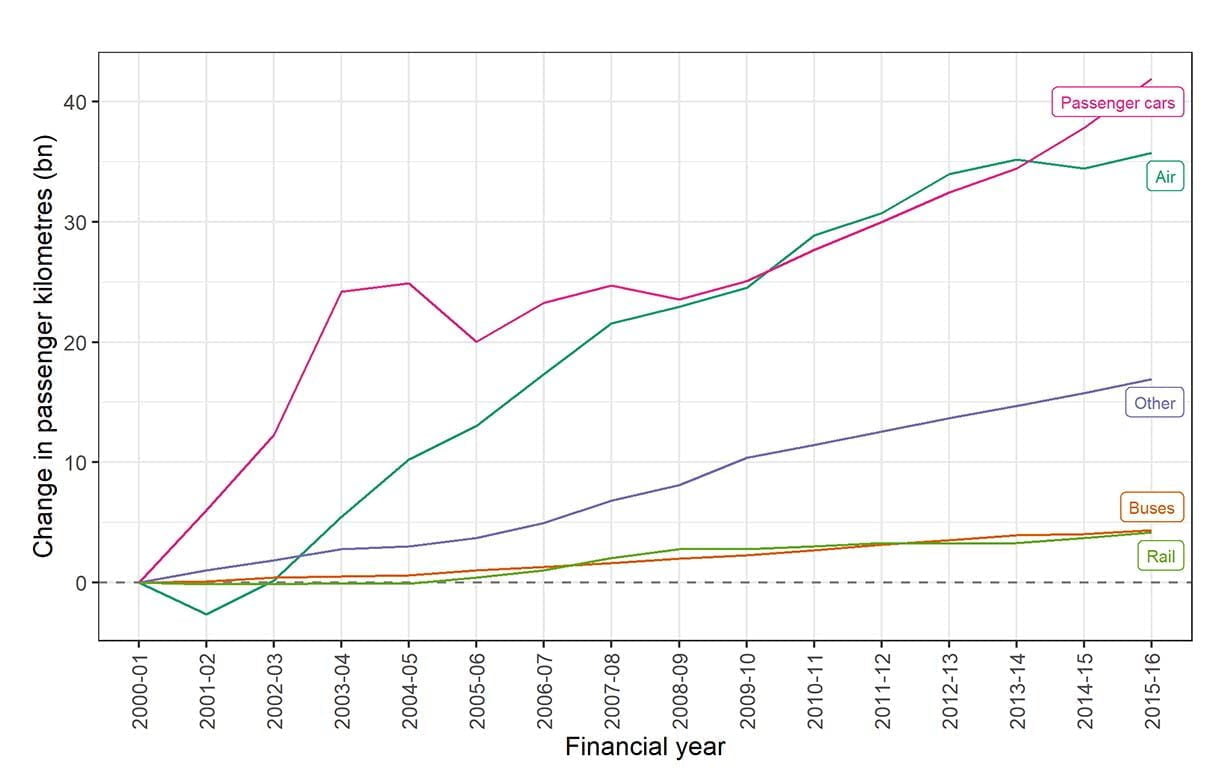
By comparison, lower cost public transport, such as bus travel, is often neglected. It represents a fairly small share of the transport task (5% of passenger kilometres in Sydney and 2% in Melbourne1,2) but can better serve the lower density areas in our cities.
The congestion resulting from commuting is very visible, yet commuting only accounts for around a quarter to a third of passenger kilometres in Sydney and Melbourne on weekdays. Most of the remaining passenger kilometres are from social or recreation-related travel (a quarter), work-related business travel (15%), shopping (10%) and ferrying passengers around (10%).1,2 Using public transport to meet all these diverse purposes with widely spread destinations is difficult, but there are many trips where improved cycling, walking and bus services could reduce car use.
Cycling and walking can make a much greater contribution to the transport task than they currently do in inner city areas, either on their own or in combination with public transport—and in suburban and regional areas where distances are short between residential, employment and retail zones. But to do so requires reallocating roadspace from cars to these far more space- and energy-efficient forms of transport. As exemplar countries such as the Netherlands have demonstrated, to encourage cycling in particular requires denser, more mixed land-use patterns, high quality separated infrastructure and deterrents to car use such as limited or expensive parking.
Can self-driving cars help?
Self-driving cars are often seen as a panacea to improve road safety and also potentially to reduce congestion and emissions. However, if a high level of automation were to be achieved, there is a risk of much greater car use as driving becomes universally available—such as to children. Government regulation and incentives would be required to manage this risk, with new business models developed that break the cultural bonds of car ownership. If a future could be achieved where car ownership is a minority activity, and instead autonomous vehicles operate similarly to taxis or ride share services today, there is potential to reduce overall vehicle kilometres travelled (although empty ‘positioning’ runs could offset any car occupancy gains), release vast swathes of urban space from car parking for more productive uses, and reduce emissions.
Planning is the long-term solution
The integration of transport and land-use planning has long been a problem in Australia, with weak government oversight between opening up new areas for development and providing high quality non-car-based transport options. In recent years this has been exacerbated by strong political intervention in transport investment, in some cases subverting considered planning (e.g. projects announced before the business case is done).
Many European countries and, increasingly, cities in North America are recognising the need for public transport to form the backbone of new developments and are building these networks alongside the developments. While there are some good examples in Australia (e.g. p. 68), most continue to pay scant attention to non-car travel options.
One example of how this can be achieved at an urban level is the suburb of Houten (pop. 50,000) on the outskirts of Utrecht in the Netherlands. This suburb was designed from the outset with cycle paths and footpaths forming the spine of the transport network, providing direct connection to shops and train stations; houses front onto the paths with roads often at the rear. Car travel is intentionally more difficult than walking or riding—almost all car trips require a circuitous drive along the outer ring road. The density of around 50 people per hectare is similar to many inner- and middle-suburban areas in Australia, and car ownership is still relatively high (420 cars/1000 residents) although not as high as the Australian average (568 cars/1000 residents). Despite the relatively high density (compared to most Australian suburbs), there is much more public open space as there is less need for roads and parking, and the balance is towards public rather than private outdoor space.
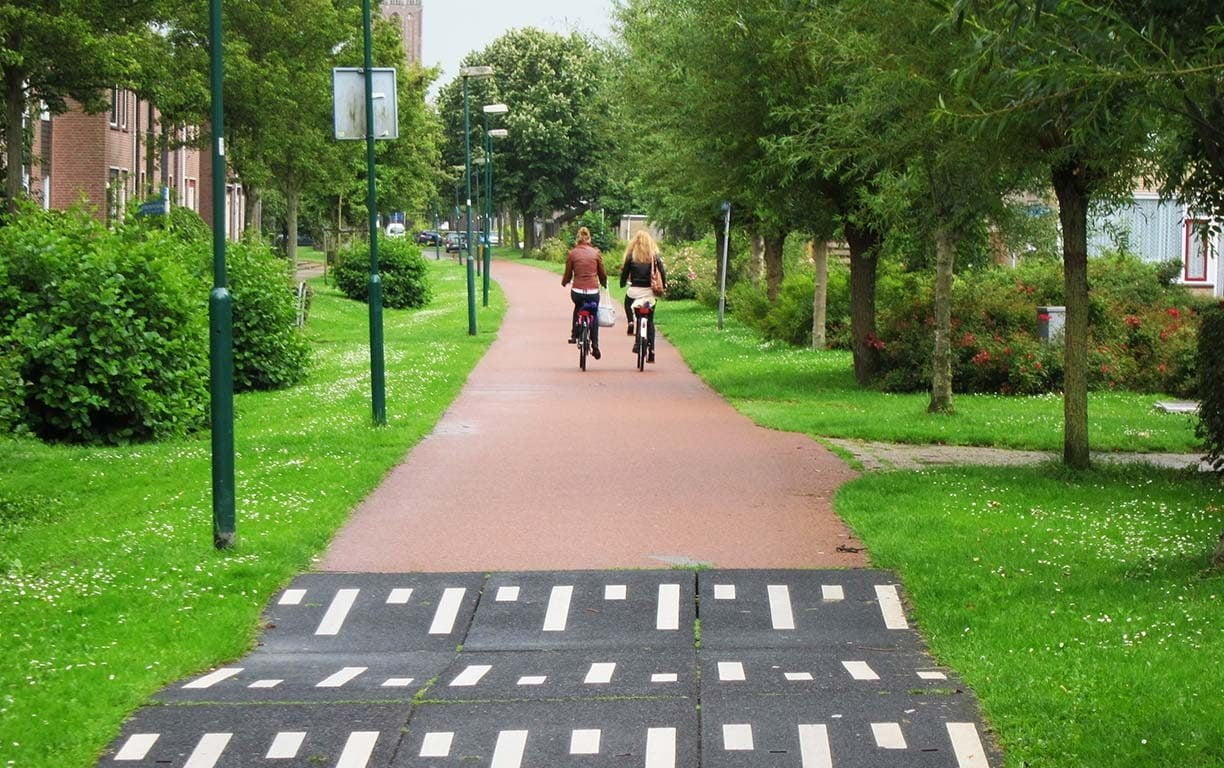
The result is that the vast majority of travel within the suburb occurs by foot or bicycle, and much travel to Utrecht and other major cities occurs by train, with undercover parking for 3000 bicycles at the main station.
Many of the principles used in Houten could easily be applied in existing Australian suburbs and towns, at least in those that have sufficient densities and mixed land uses. This could include partial road closures that preclude ‘rat running’, but provide easy and direct connections by walking or riding. This provides both a disincentive to use cars for short trips (‘stick’), and an incentive to walk or ride (‘carrot’). Transport choices are made based on the relative attractiveness of the modes; we are unlikely to achieve the required shifts without a combination of both carrot and stick.
Mixed use development is also important. The classic pre-car model of development with moderate density and residences intermingled with shops and employment centres shows how we used to be able to do this.
Getting to genuine transport sustainability
It’s not only about emissions. The pre-eminent contribution of the car in Australia has come about partly because of a long history of failing to account for the external costs of driving, such as the pollution, injuries and deaths, noise, land taken and community severance. These costs are borne by the community as a whole, not just by car drivers.
To achieve the radical reduction in transport emissions that is required will demand a rapid technological shift towards electrification supported by renewables, and a massive shift from the least energy-efficient forms of transport (especially the private car) towards the most efficient (walking, cycling and public transport). This will require both carrots and sticks: the most efficient forms of transport will need to be made much more attractive and the least efficient less attractive. A drastic change in approach and priorities is needed: we need a reversal of the current practice which favours the least efficient.
1. Transport for NSW Household Travel Survey, www.transport.nsw.gov.au/data-and-research/passenger-travel/surveys/household-travel-survey-hts
2. Victorian Integrated Survey of Travel and Activity, transport.vic.gov.au/about/data-and-research/vista/vista-data-and-publications
3. ABS, 2019 Survey of Motor Vehicle Use, Cat. 9208.0, www.abs.gov.au/ausstats/abs@.nsf/mf/9208.0
4. National Transport Commission, www.ntc.gov.au/topics/environment/light-vehicle-emissions
5. Dept of Environment and Energy, www.energy.gov.au/publications/australian-energy-statistics-table-o-electricity-generation-fuel-type-2017-18-and-2018
Further reading
 Transport & travel
Transport & travel
Petroleum is fast becoming a dirty word
John Hermans explains the negatives of the petroleum industry.
Read more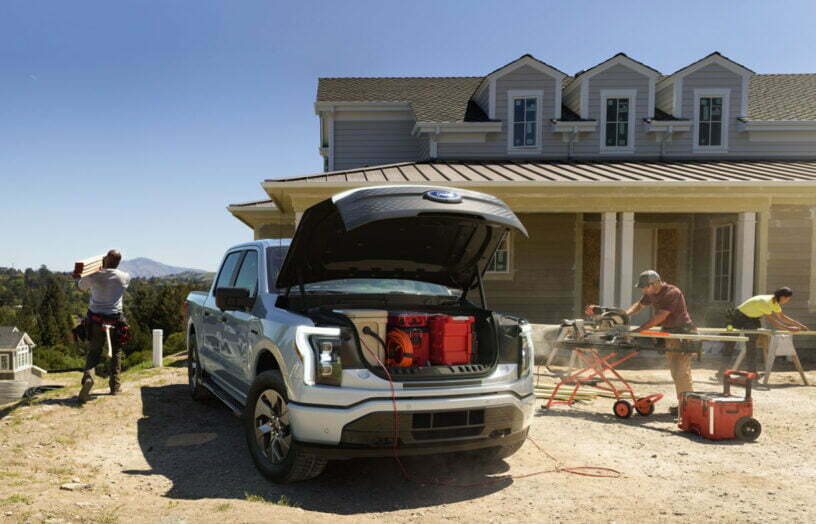 DIY
DIY
Bring on the electric ute
Bryce Gaton asks, will 2023 be the Australian ‘Year of the electric light commercial vehicle’?
Read more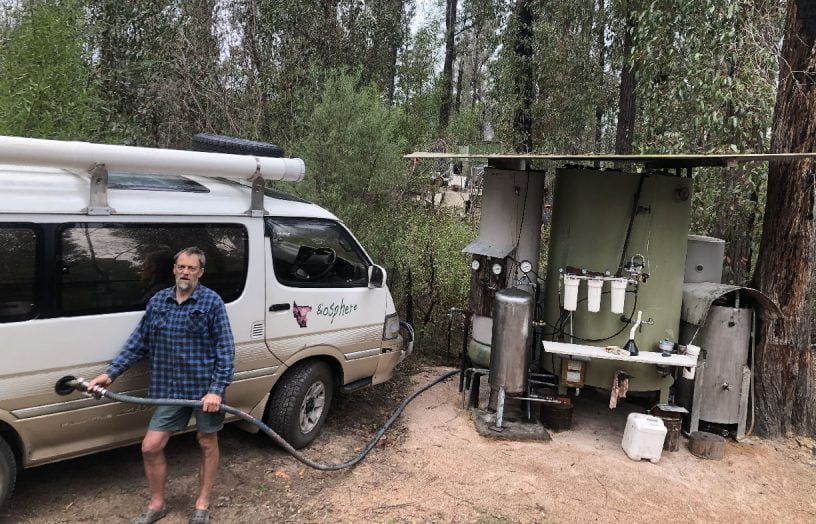 Transport & travel
Transport & travel
Biofuel vs battery
John Hermans gives his opinion on the best power source for electric vehicles.
Read more

